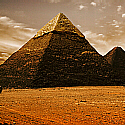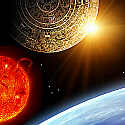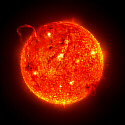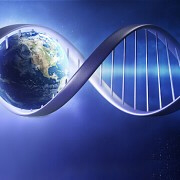Ruin Restoration
Written By: CK Quarterman
“And the earth was without form, and void; and darkness was upon the face of the deep. And the Spirit of God moved upon the face of the waters.” (Gen. 1:2)
The Ruin-Reconstruction Theory suggests that there is a gap of time between a distinct creation event in the first verse of Genesis and the second recreation in the second verse of Genesis, explaining the age of the Earth.
And the earth was (hâyâh) without form, (tôhû) and void; (bôhû) and darkness (chôshek) was upon the face of the deep.(tehôm tehôm) And the Spirit (rûach) of God (‘ĕlôhı̂ym) moved (râchaph) upon the face of the waters. (Gen 1:2 Hebrew)
hâyâh – become, come to pass, became
tôhû – desolation, or become worthless.
bôhû – ruin
chôshek – destruction
tehôm tehôm – abyss
rûach – breath
râchaph – to brood as a mother hen
The Ruin-Reconstruction theory, known as Gap Creationism, suggests a time lapse exists between a distinct creation event in Genesis’ first verse and the second recreation that takes place in the second verse, explaining the Earth’s age. This concept suggests that science has proven the Earth is much older than accounted for by adding up biblical chronology.
Furthermore, the Ruin-Reconstruction theory maintains the Genesis Creation account is inerrant in scientific fact. Gap Creationists assert that the biblical account lapse lasted an unknown number of years (between a first creation in Genesis 1:1 and a second recreation in Genesis 1:2). This allows for various observations, including; determining the Earth’s age as well as that of the universe, dinosaurs, oil formation, ice ages, and geological formations that occurred as outlined by science without contradicting a literal belief in Genesis.
In contrast, the Ruin-Reconstruction theory differs from “Day-age Creationism” and “Young Earth creationism.”
Day-age creationism claims that the days of creation were much longer (thousands or millions of years). Young Earth Creationism, although it agrees concerning the six literal 24-hour days of creation, does not suggest a time gap.
The Ruin-Reconstruction concept alleges that a cataclysmic judgment was pronounced upon the earth (between the 1st and 2nd verse) due to the fall of Lucifer. In addition, other verses of Genesis describe a reforming of the earth from a chaotic state. The E.W. Bullinger Companion Bible of 1909 clearly shows the Ruin – Restoration theme of Genesis:
The beginning God (prepared, formed, fashioned, and) created the Heavens and the earth (Perfect, complete and to be Inhabited). And the earth became waste, and void; and darkness was upon the face of the deep (Frozen Ice). And the Spirit of God moved (hovering, brooding); [the beginning of the heavens and earth which are now] upon the face of the waters [Melted Ice]. (Gen. 1:1-2, EWB-CB)
The six days of Genesis are the account of a re-creation, or regeneration of a previously existent heavens and earth (not the original creation), and seven creative days within Genesis chapter one are not a geological history of the earth!
Ruin-Reconstruction relies upon specific linguistic reasoning behind the Hebrew Scriptures. First, a newly created earth should not have been without form and void. Second, the word “was” in Genesis 1:2 is more accurately translated as “became.” The Hebrew word for “was” is haw-yaw’ and means “become”, or come to pass. Third, “create” and “made” are different in the Hebrew language as well. “Create” (bara in Hebrew) means to call forth out of nothingness. The Christian doctrine “Ex nihilo” has a Latin phrase meaning “out of nothing” from this Hebrew word. Subsequently in the text, the words “make” or “form” (asah in Hebrew) mean a re-fashioning or making from pre-existing material. This refers to the substance remaining after the earth underwent Lucifer’s judgment.
Hebrews 11:3 says, “By faith we understand that the worlds were framed by the word of God, so that the things which are seen were not made of things which are visible.”
This means that the heavens and the earth came into existence by divine command and was not assembled from pre-existing matter or energy. Further support can be seen in Isaiah 45:18 where it is stated that the earth was not created in “vain” (tohu), “He (God) formed (asah) it (the earth) to be inhabited.” The word “was” or “became” in Genesis 1:2, allows a change of state to occur from verse one to verse two and is more accurately translated “became”. That is, the initial perfect creation of verse one “became” without form and void, indicating a transition occurred. Genesis 1:2 reveals that,
“And the earth was (had become) without form, and void; and darkness was upon the face of the deep. And the Spirit of God moved upon the face of the waters.” (Genesis 1:2)
Additional support comes from the phrase “without form and void.”
Consider other Biblical texts in which these words are found together. In Isaiah 24:1 and Jeremiah 4:23, one sees that they are judgmental in character and context.
Jeremiah describes a time when the earth was “without form, and void.” Noah’s flood was not even as horrific nor brought such barren conditions as described by Jeremiah. It can only be a cataclysmic destruction by God of the Pre-Adamic world. Remember, Isaiah 45:18 states:
“God did not create the earth in vain; he formed it in order for it to be inhabited”.
Jeremiah also wrote:
I beheld the earth, and, lo, it was without form, and void; and the heavens, and they had no light. I beheld the mountains, and, lo, they trembled, and all the hills moved lightly. I beheld, and, lo, there was no man, and all the birds of the heavens were fled. I beheld, and, lo, the fruitful place was a wilderness, and all the cities thereof were broken down at the presence of the LORD, and by his fierce anger. For thus hath the LORD said, The whole land shall be desolate; yet will I not make a full end.
For this shall the earth mourn, and the heavens above be black: because I have spoken it, I have purposed it, and will not repent, neither will I turn back from it (Jeremiah 4:23-28).
There were no descendants of Adam (no man), yet there were cities that God destroyed by his wrath – who dwelt in these cities? According to Hebrew Cosmogony, Earth was changed by catastrophe, before the birth of our world as we know it. Worlds were shaped and brought into existence, only to be destroyed in the course of time, not to be inhabited by man. He made several worlds before ours, but he destroyed them all. Hebrew mythology assigns this to a period before Adam and different geophysical catastrophes. It should also be noted that DNA remains actually older than 6,000 years (like “Neanderthal” and “Cro-Magnon”) will be found to have no genetic connection to any people living on the Earth today.
Questions answered by the Ruin-Reconstruction theory include: (1) How can the Earth only be 6,000 years old, according to the Bible’s chronology, when the forensic evidence of geology and the fossil records reveal that the Earth is very ancient?
(2) How could death have only started with the fall of man at about 6,000 years ago when evidence for death is found in the Pleistocene geologic era, and a long reign of death across ancient ages past? (3) How can man have been on the Earth for only about 6,000 years when there is evidence of man-like creatures inhabiting the Earth for hundreds of thousands of years? What happened during this Gap between Genesis 1:1 and 1:2?
One also wonders, what took place during this time gap between Genesis 1:1 and 1:2. Around the Cambrian geologic period (about 500-600 million years ago), an explosion of death happened to well-developed life forms in the fossil record, with no antecedent fossils in the more ancient Precambrian, except for what could be primitive cell remains. Consequently, what appears in the fossil record as an explosion of life was actually an explosion of death. Living things do not leave remains until they die. The Cambrian geologic period marks the first record of death and the fall of Lucifer. Because Lucifer was the steward of the whole creation under heaven when he fell, all things under his rule were also subjected to corruption.
Adam’s sin brought death into our world (Romans 5:12). Therefore, it is no contradiction with the Bible that Earth’s geology shows an ancient track record of death on this planet long before Adam. As seen throughout the geologic record, there is evidence of mass extinction and geologic catastrophes.
Recapping, in Gen. 1:1, the word created is baw-raw’ and means to create out of nothing. After, Gen. 1:1 the word “made” is used but it is a different word in Hebrew, known as aw-saw,’ and means “to make out of existent materials.” This is translated as made instead of create so the reader knows it is a different assertion.
In verse one of Genesis, God created. Thereafter, God made or recreated from existent material the Earth from material he had created out of nothingness in the first verse.
The science behind both Carbon and Argon data is flawed, but not by millions of years. Carbon and Argon dating based upon radioactive decay may have been accelerated in the recent past. However, the vast age assigned to the earth based on radioactive measurements can by no means be set aside.
Is there another reasonable explanation for a literal six-day creation that explains the great age of the earth? Perhaps, if one is willing to say that science is very wrong and that the earth is not but 10,000 years old, and that God is tricking the scientists. Many Christians champion a six-day creation, Ex nihilo. In order to do so, one has to deny the geological evidence of the Earth’s vast age. Furthermore, no scriptures warrant an arbitrary assumption that a day is more than 24 hours long. Believing that a day is 24 hours is a general principle in the absence of any statement to other effect. Therefore, one must except the days of Genesis are literal 24 hour days.
Thus, Ruin-Restoration Creationism best fits the overall understanding of the creative acts of Elohim. In summary, Elohim existed and created the earth perfectly (Genesis1:1), but it became a wasteland because of war in the heavens (Genesis 1:2). Elohim then remade the earth out of the old materials of the previous creation in a literal six-day period. Ruin-Restoration Creationism proves that the Biblical story of creation is in harmony with the teachings of modern science, and this casts a new light on the integrity of the Bible.





